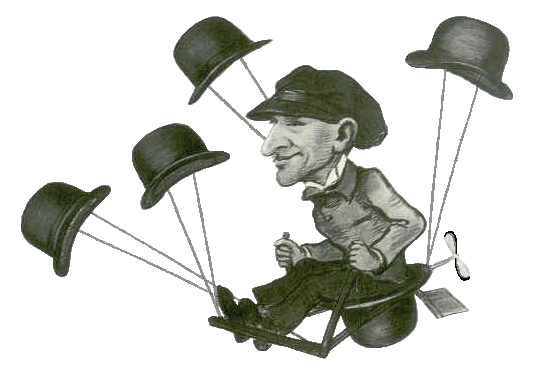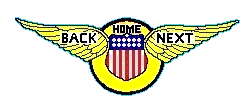
Important Events in Balloon History
 Important Events in Balloon History |
Aerodacious(Aviation + Audacious = Aerodacious)eMail: AerodaciousPage LF-003 (Revised 01/22/2006) |
| Year | Month/Day | Person | Balloon Event |
| 1400 | Roger Bacon | Suggested a plan of flotation of a large hollow sphere of very thin copper, to be filled with "etherial or liquid fire." Believed air to have a definite consistency and capable of sustentation like water. No definite record of actual experimentation. | |
| 1670 | Francesco Lana | Suggested four copper balls of thin walls, and entirely exhausted of air. Balls each to be 20 feet in diameter, and so thin that each weighed less than an equal bulk of atmosphere. Fallacy consisted in the physical condition that the walls would be too thin to withstand atmospheric pressure. The construction may be regarded as the prototype of the modern balloon. | |
| 1709 | Aug 8 | Bartholomeo-Lourenco de Gusmao | Causes what is probably a hot-air balloon or a gas balloon to rise to ceiling of the Palace of Indies in Lisbon, Portugal. |
| 1767 | Dr. Black | Of Edinburgh suggested the use of hydrogen with a thin bladder bag. | |
| 1782 | Jun 20 | Tiberius Cavallo | Presents a note to Royal Society describing successful experiments with hydrogen-inflated soap bubbles. |
| 1782 | Nov | Stephen & Joseph Montgolfier | Used a hot-air balloon to lift a load. |
| 1783 | Jun 5 | Joseph Montgolfier & his brother | At Annonay, France, a balloon of 35 feet diameter, filled with hot. air, is sent up attaining a height of more than one mile. |
| 1783 | Jun 26 | Charles | At Paris, France, a hydrogen balloon is sent by this scientist. |
| 1783 | Aug 30 | Charles | Sent up a 12-foot diameter balloon, made of oiled silk and filled with hydrogen, on the Champ de Mars, Passy. |
| 1783 | Sep 19 | J. Montgolfier | Hot air balloon is sent up with sheep, rooster and duck, all landing uninjured. |
| 1783 | Nov 21 | Pilatre de Rozier & Marquis d'Arlandes | At La Muette palace, near Paris, hot-air balloon rises with both men and descends safely in 20 minutes. |
| 1783 | Dec 1 | Charles and Roberts | Hydrogen balloon covers three miles in two hours, leaving the Tuileries and landing near Nesle, France. |
| 1783 | Dec 26 | Sebastien Lenormand | Descends by parachute from the Tower of the Montpelier Observatory. |
| 1784 | Jan 19 | At Lyons, seven passengers ascend in La Flaselle hot-air balloon, the largest of its type ever constructed 100 x 130 feet. | |
| 1784 | Mar 2 | Blanchard | Tried to steer with aerial oars. |
| 1784 | Aug 27 | Tytler | Made the first ascent in England, using a cloth bag covered with varnish. |
| 1784 | Sep 19 | Roberts Brothers | Use fish-shaped balloon, oars and rudder, and changed course 22 degrees in calm air. French experiment. |
| 1784 | Dec 17 | Roberts and Charles | Took up a hydrogen balloon of over 10,000 cubic feet. |
| 1784 | Dec 17 | General Meusnier | Introduced the principle of ballonnet, in a balloon equipped with hand-worked propellers. Propelling scheme anticipated by the Roberts Brothers. |
| 1784 | Dec 17 | Lunardi | Made the first flight over London. |
| 1785 | Jan 7 | Jeffreys and Blanchard | Cross the channel from Dover, landing in the Province of Artois. |
| 1812 | Leppig | Uses a fish-shaped balloon, with free propellers. Unsuccessful. Russian experiment. | |
| 1834 | Count de Lennox | Attempted a ballon flight in a cylindrical balloon 130 feet long, and fitted with twenty oar propellers. French experiment. | |
| 1836 | Nov 7 | Messrs. Robert Holland, Charles Green, & Monck Mason | Sail in a coal gas balloon in eighteen hours from London to Weilburg, Nassau, a distance of 500 miles. |
| 1848 | Hugh Bell | Used screw propellers on a cylindrical balloon, 65 feet long. English experiment. | |
| 1852 | Sep 23 | Henry Gifford | Makes a voyage with a dirigible from Paris to Trappes and back, with rudder and steam motor. Balloon was spindle shaped, 130 feet long; motor developed 3 horse power. In still air, had speed of 4 mph; winged propellers used. French experiment. |
| 1853 | Oct 4 | Felix Tournachan | Flies the "Geant," a free type balloon of 215,000 cubic feet from Champ de Mars to Meaux, carrying fifteen people. Bag equipped with compensating ballonnet, suggested by ML Godard. |
| 1859 | Jun 23 | John Wise | Sails from St. Louis, MO to Henderson, NY, distance of 809 miles. |
| 1862 | Sep 5 | (James) Glaisher and Coxwell | Ascend 37,000 feet, according to Mr. Glaisher's reckoning. They are credited with about six miles, starting from Wolverhampton, England. |
| 1869 | Henry Gifford | Made two ascensions in a captive balloon of 460,000 cubic feet capacity, from Habburnham Park. | |
| 1870 | De Lome | Flew in a spindle-shaped balloon 110 feet long, using screw propellers and sail-like rudder. Apparatus was operable. French experiment. | |
| 1872 | Haenlein | Attained successful flight with a cylindrical balloon 165 feet long, using a cylinder gas engine of 2.8 horse power. Austrian experiment. | |
| 1883 | Tissandier Brothers | Successfully drive a spindle-shaped balloon 90 feet long, using a Siemens electric motor. French experiment. | |
| 1884 | Aug 9 | Captain Charles Renard | His "La France," dirigible, with 9 HP motor, makes successful flight, showing complete control. In seven trials, in the course of two years, it returned to its point of departure five times out of seven. Speed, 14.5 mph. Had the ballonnet of Meusner; used the suspension system of De Lome, and the electric equipment of Tissandier Brothers. Bag was 160 feet long; propeller placed at front; carriage to balance weight of rudder at rear end. French experiment. |
| 1886 | Woelfert | Flies with a cigar-shaped balloon, 91 feet long; equipped with a Daimler motor and a two-bladed aluminum propeller. German experiment. | |
| 1893 | Schwartz | Suggested the use of an aluminum structure. Russian experiment. | |
| 1895 | Schwartz | Operating in Germany, built an aluminum airship, 150 feet long fitted with a 12 HP Daimler motor. | |
| 1897 | Jul 11 | Andree | Made an attempt to reach the North Pole, accompanied by Frankel, Svedenborg and Strindberg. |
| 1898 | Zeppelin | Built a cigar-shaped rigid airship, 418 feet long, fitted with two 16 HP motors. German experiment. | |
| 1900 | Jul 2 | Zeppelin | In Zeppelin I makes first flight from Lake Constance. |
| 1900 | Oct | De la Vaulx | Makes flight from Vincennes, France, to Korostcheff, Russia, a distance of 1,193 miles, in 36 3/4 hours. (Largest balloon flight recorded to 1911). |
| 1900 | Roze | Suggests the use of a double airship. | |
| 1901 | Jul 31 | Prof. Berson and Dr. Suring | Ascend from Berlin to an altitude of 35,425 feet in the hydrogen balloon "Preussen," 300,000 cubic feet. |
| 1901 | Oct 19 | Santos Dumont | Sailed from St. Cloud around the Eiffel Tower, and returned within half an hour. Won the "Deutsch Prize." Balloon was 108 feet long, 20 feet diameter and fitted with a gasoline motor of 18-20 HP, Velocity 19 miles per hour. French experiment. |
| 1902 | Lebaudy Brothers | Launch non-rigid dirigible "Jaune," attaining a speed of 26 mph Length, 180 feet, diameter, 32 feet; filled with 80,600 cubic feet hydrogen; fitted with a 40 HP Daimler motor, operating twin propellers. Ballonnets used. | |
| 1904 | The "Lebaudy" accepted by French War Department. Same type as the "Jaune." | ||
| 1906 | Julliot | Designed and built the "Patrie." General cigar-shaped form of Renard used. Length was 197 feet, diameter, 33 feet. Fitted with horizontal and vertical stabilizing planes at stern of bag; also a directive rudder at rear of framework. Volume 128,900 cubic feet. Car had exceptionally long suspension, from an elliptical frame-work of steel tubes. | |
| 1907 | Oct 12 | HE Gaudron, JL Launer and CC Turner | Attempted to break world's record for distance (1,193 miles, held by Count de la Vaulx). Balloon ascended from Crystal Palace, crossed the North Sea, from Yarmouth to north coast of Denmark, a sea-distance of 360 miles. This is largest over-sea voyage made to time of flight. Journey ultimately terminated at shore of Lake Wener in Sweden. Total distance 702 miles. |
| 1907 | Nov 23 | The "Patrie" sailed from Chalais to Verdun, 1.87 miles, in 6 hours and 45 minutes, against a light wind. | |
| 1908 | Nov | AE Gaudron, EM Maitland and CC Turner | Made a flight from London, England, to Mateki, Dereveni, Russia—1,117 miles in 31 1/2 hours. Longest flight made from England. |
| 1908 | Nov | The German Government purchases the "Gross I," "Parseval I" and "Zeppelin I." | |
| 1908 | Nov | United States War Department purchases Thomas R. Baldwin's dirigible, 96 x 19 1/2 feet, with Curtiss 20 H. P. motor. | |
| 1909 | The non-rigid dirigible "Espana" travels from Beauval to Paris and return in five hours, ten minutes at 31 mph. | ||
| 1910 | Oct 17 | AR Hawley & Augustus Post | Travel in "America" from St. Louis to North Lake Chilogoma, Canada, a distance of 1,172.9 miles. |
| 1910 | Oct 26 | French build dirigible for English Government. | |
| 1910 | Oct 26 | The "Morning Post" makes flight from Moisson to Farnborough, a distance of 230 miles, in 5.5 hours. Speed almost 42 mph. | |
| 1912 | Oct 27 | Bienaime and Rumpelmager | Start on a journey from Stuttgart to Riazau, Russia, 1,375 miles. |
| 1913 | Jun 19/21 | Rumpelmager & William Goldschmidt | Sail from Lamotte, Brenil to Voitchy, Kharkoff, 1,600 miles. |
| 1914 | Feb 8/10 | "Berliner" sails from Bitterfeld to Bigsertsk in Peru, 1,895 miles. |
